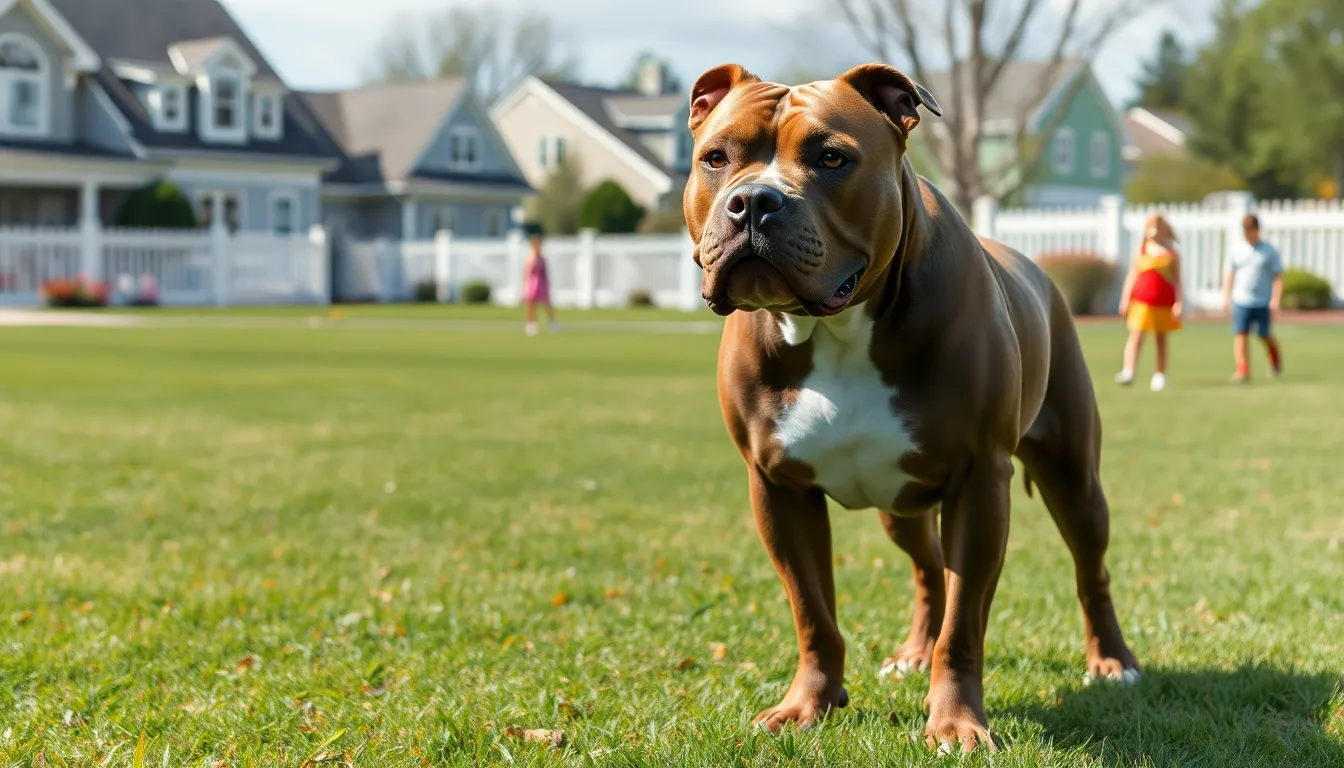Table of Contents
TogglePit bulls often spark intense debates about their temperament and behavior. Known for their strength and loyalty, these dogs can also be perceived as dangerous. Many people wonder how quickly a pit bull could inflict harm, especially in aggressive situations. Understanding the factors that contribute to a pit bull’s behavior is crucial in addressing these concerns.
While stories of attacks can be alarming, it’s essential to approach the topic with a balanced perspective. Factors like training, environment, and socialization play significant roles in a dog’s behavior. By examining the realities behind pit bull aggression, one can gain insight into their true nature and the risks involved. This article delves into the speed and circumstances under which a pit bull might pose a threat, aiming to inform and educate rather than instill fear.
Understanding Pitbulls
Pit bulls possess specific characteristics and traits that influence their interactions with humans and other animals. Familiarity with these attributes is essential for understanding their behavior.
Breed Characteristics
Pit bulls typically feature a muscular build, strong jaws, and a short coat. Weights for adult pit bulls range from 30 to 85 pounds, depending on the specific breed type, such as the American Pit Bull Terrier or the Staffordshire Bull Terrier. Height generally falls between 17 to 21 inches at the shoulder. These dogs display notable strength and endurance, making them capable of physical tasks. Their intelligence allows for quick learning, often excelling in obedience training. However, their physical attributes alone do not equate to aggression.
Behavioral Traits
Pit bulls exhibit a range of behavioral traits influenced by socialization and training. Common traits include loyalty, playfulness, and a protective nature. Early socialization with people and other animals fosters positive behavior patterns. They often form strong bonds with their families, showing affection and companionship. Misunderstandings about aggression stem from inadequate training or neglect. Structured environments and consistent training enhance their temperament, mitigating any potential aggressive tendencies.
Factors Influencing Aggression

Understanding the factors influencing a pit bull’s aggression provides insight into their behavior. Key elements include environment, socialization, training, and owner influence.
Environment and Socialization
Environment plays a crucial role in a pit bull’s behavior. Dogs raised in a stable, loving environment often display better social skills and reduced aggression. Positive interactions with humans and other animals throughout a pit bull’s early life cultivate friendly behavior patterns. Socialized pit bulls are less likely to react defensively or aggressively when encountering new situations or individuals. Conversely, a lack of positive experiences can lead to fear and insecurity, which may contribute to aggressive behavior.
Training and Owner Influence
Training significantly impacts pit bull behavior. Consistent, positive reinforcement techniques promote good behavior and obedience. Well-trained pit bulls respond better to commands and exhibit increased confidence. Owners play a vital role in shaping their dog’s behavior through guidance and interaction. An owner’s approach to discipline, boundaries, and socialization directly influences a pit bull’s temperament. Responsible ownership, coupled with proper training, fosters a more balanced dog, reducing the likelihood of aggressive incidents.
Pitbull Attacks: Statistics and Reality
Understanding pit bull attacks requires examining the frequency and severity of incidents associated with this breed. Statistics reveal a nuanced reality that often diverges from popular misconceptions.
Frequency of Incidents
Incidents involving pit bulls account for a significant portion of reported dog attacks. According to a study by the Centers for Disease Control and Prevention (CDC), pit bulls were involved in approximately 33% of dog bite-related fatalities from 1979 to 1998. More recent data indicates that pit bulls continue to be frequently reported in attack statistics. However, it’s important to contextualize these numbers; the overall incidence of dog bites is much higher than fatalities, with the ASPCA noting that about 4.5 million Americans are bitten by dogs each year.
Severity of Attacks
The severity of pit bull attacks often raises concern among the public. A report from the Journal of the American Veterinary Medical Association highlighted that pit bulls represent a higher percentage of severe injuries than other breeds. However, this doesn’t necessarily reflect inherent aggression; rather, it may correlate with their size and strength. In 2020, the dog bite fatality report by DogsBite.org listed pit bulls as responsible for 67% of dog-related deaths. Evaluating the severity of these incidents emphasizes the need for responsible ownership, training, and socialization to mitigate risks associated with pit bull aggression.
The Myth of Pitbull Speed
Many misconceptions exist about pit bulls, particularly regarding their speed and aggression. Understanding the facts behind these beliefs can help clarify the reality of pit bull behavior.
Physical Capabilities
Pit bulls exhibit impressive physical attributes, including muscular builds and strong jaws, contributing to their overall strength. On average, a pit bull can run at speeds of 15 to 20 miles per hour. This speed, while notable, does not equate to an inherent danger to humans. A dog’s behavior is primarily influenced by training, socialization, and individual temperament, rather than mere physical ability.
Misconceptions in Popular Culture
Misrepresentations of pit bulls in media and popular culture fuel excessive fear surrounding their temperament. Films and news stories often portray them as aggressive and dangerous, overlooking the significance of environmental factors and training. These portrayals create a skewed perception, leading to the belief that pit bulls are uniquely lethal. In reality, any breed can exhibit aggressive behavior if not properly trained or socialized. Understanding these nuances is crucial in dispelling myths surrounding pit bull aggression and speed.
Safety Measures and Responsibility
Understanding safety measures and responsibilities is crucial when considering interactions with pit bulls. Awareness and proactive steps can prevent unfortunate incidents.
Preventing Dog Attacks
Preventing dog attacks requires clear strategies.
- Socialization: Early and consistent socialization reduces fear and aggression. Exposing pit bulls to various environments, people, and animals encourages positive behavior.
- Training: Structured training helps control behavior. Using positive reinforcement techniques promotes obedience and builds a strong bond between the owner and the dog.
- Supervision: Always supervise interactions between dogs and children. Adult supervision ensures safety and allows for immediate intervention if necessary.
- Leash and Muzzle Use: When in public or unfamiliar areas, using a leash and, if needed, a muzzle can prevent potential incidents. Control reduces risks associated with unexpected encounters.
- Health Check: Regular veterinary check-ups ensure the dog is free from pain or health issues that could trigger aggression.
Responsible Ownership Practices
Responsible ownership cultivates better behavior in pit bulls.
- Commitment: Owning a dog requires a long-term commitment. Owners must invest time and resources into training, exercise, and socialization.
- Knowledge: Understanding breed characteristics and behaviors equips owners to manage their pets effectively. Education on pit bull traits helps in addressing specific needs and challenges.
- Community Engagement: Participating in community training classes promotes responsible dog ownership and socialization. Engaging with other dog owners fosters a supportive environment and shared knowledge.
- Legal Awareness: Familiarizing oneself with local laws regarding pit bull ownership ensures compliance and safety. Owners should know regulations that pertain to leashing, muzzling, and neighborhood policies.
- Emergency Preparedness: Having a plan for emergencies enhances safety. This includes knowing veterinarians, emergency services, and having identification for the dog in case of loss.
Implementing these measures ensures a safe environment for both pit bulls and people, promoting a harmonious coexistence.
Understanding the dynamics of pit bull behavior is crucial for fostering a safe environment. Recognizing that a dog’s aggression often stems from its upbringing rather than its breed can shift perceptions. Responsible ownership and proper training are vital in shaping a pit bull’s temperament.
By focusing on socialization and providing a stable environment, owners can significantly reduce potential risks. It’s essential to educate the public about the realities of pit bulls, moving beyond sensationalized narratives. Through informed approaches and community engagement, it’s possible to promote a more balanced view of these dogs, ensuring safety for both humans and pets.







